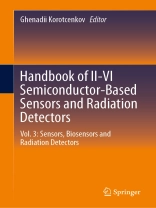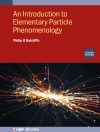The reference provides interdisciplinary discussion for diverse II-VI semiconductors with a wide range of topics. The third volume of a three volume set, the book provides an up-to-date account of the present status of multifunctional II-VI semiconductors, from fundamental science and processing to their applications as various sensors, biosensors, and radiation detectors, and based on them to formulate new goals for the further research. The chapters in this volume provide a comprehensive overview of the manufacture, parameters and principles of operation of these devices. The application of these devices in various fields such medicine, agriculture, food quality control, environment monitoring and others is also considered. The analysis carried out shows the great potential of II-VI semiconductor-based sensors and detectors for these applications.
- Considers solid-state radiation detectors based on semiconductors of II-VI group and their applications;
- Analyzes the advantages of II-VI compounds to develop chemical and optical gas and ion sensors;
- Describes all types of biosensors based on II-VI semiconductors and gives examples of their use in various fields.
表中的内容
Basic principles of solid state X-ray radiation detector operation.- Cd Te and Cd Zn Te-based radiation detectors.- Zn Se and Cd Se-based radiation detectors.- Cd S and Zn S-based radiation detectors.- Medical application of II-VI semiconductor-based radiation detectors .- Introduction in gas and humidity sensing .- II-VI semiconductor-based thin film electric and electronic gas sensors.- Nanocomposite and hybrid-based electric and electronic gas sensors.- II-VI semiconductor-polymer nanocomposites and its gas sensing properties .- Nanomaterial-based electric and electronic gas sensors.- II-VI-based electric and electronic humidity sensors .- II-VI-based optical gas sensors.- Spectroscopic gas sensing systems .- II-VI-based luminescence and fluorescence ion sensors.- Photoelectrochemical ion sensors .- II-VI semiconductor-based optical temperature sensors.- Introduction in biosensing.- Fluorescent biosensors based on II-VI QDs.- QD-based chemiluminescent biosensors.- Electrochemiluminescent biosensors based on II-VI QDs .- Electrochemical biosensors.- Photoelectrochemical biosensors.- Surface plasmon resonance biosensors .- Biosensors based on II-VI semiconductor quantum dots for health protection .- Application of II-VI semiconductor-based biosensors in nanomedicine and bioanalysis.- Applications of II-VI semiconductor-based biosensors for food analysis and food safety.
关于作者
Doctor Hubilitate Ghenadii Korotcenkov has more than 50 years of research experience in the field of materials science and the development and research of various devices based on semiconductor materials. Until 1995 he studied Schottky barriers, MOS structures, native oxides, and various photoreceivers based on III–Vs compounds such as In P, Ga P, Al Ga As, and In Ga As. His current research interests since 1995 include material sciences, focusing on metal oxide film deposition and characterization (In2O3, Sn O2, Zn O, Ti O2), surface science, thermoelectric conversion, and design of physical and chemical sensors, including thin film gas sensors.His scientific work has been recognized with numerous awards, including National Prize of the Republic of Moldova (2022), an Award of the Academy of Sciences of Moldova (2019), the Prize of the Presidents of the Ukrainian, Belarus, and Moldovan Academies of Sciences (2003) and others. G. Korotcenkov also received a fellowship from the International Research Exchange Board (IREX, United States, 1998), Brain Korea 21 Program (2008-2012), and Brain Pool Program (Korea, 2007-2008 and 2015-2017).












